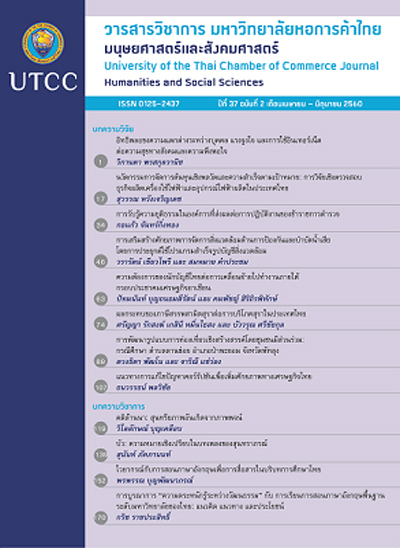โวหารรัก” ในบทเพลงของสุนทราภรณ์
Main Article Content
บทคัดย่อ
บทเพลงของสุนทราภรณ์ที่มีเนื้อหาเกี่ยวกับความรักและความพิศวาส เป็นบทเพลงที่มีลักษณะเด่น ด้านการใช้ภาษาในเชิงเปรียบเทียบ ที่เรียกว่า “โวหารภาพพจน์” จากการศึกษาวิเคราะห์บทเพลงในอัลบั้ม“ที่สุดของเพลงรัก สุนทราภรณ์” จำนวน 50 บทเพลง พบว่า ผู้ประพันธ์บทเพลงเลือกใช้โวหารภาพพจน์ประเภทอุปมาและอติพจน์เป็นหลักในการสื่อความหมาย สื่อภาพ และสื่ออารมณ์ความรู้สึก โดยแบ่งการวิเคราะห์ได้เป็น 3 ลักษณะใหญ่ ๆ คือ 1. ชมนาง: การชมความงามของหญิงผู้เป็นที่รัก 2. คำมั่นสัญญา: ถ้อยคำที่สร้างความมั่นใจในความรัก และ 3. การพลัดพราก: ความทุกข์ ความโศกเศร้า และความสะเทือนใจ การเลือกใช้โวหารภาพพจน์มากล่าวในเชิงเปรียบเทียบส่วนใหญ่เป็นไปตามขนบในการแต่งวรรณคดีที่มีมาแต่เดิม กล่าวคือ ในการ “ชมนาง” ผู้ประพันธ์มักเปรียบเทียบความงามของผู้หญิงกับธรรมชาติ บุคคลหรือเทพเจ้า การถ่ายทอด“คำมั่นสัญญา” มักเชื่อมโยงกับธรรมชาติ และแนวคิดทางพระพุทธศาสนา ส่วนการสื่อให้เห็นความทุกข์ความโศกเศร้า และความสะเทือนใจจาก “การพลัดพราก” ผู้ประพันธ์มักเปรียบเทียบกับชีวิตที่สูญสิ้น และเปรียบเทียบกับสภาพความเป็นไปของธรรมชาติ
Article Details
ลิขสิทธิ์ของบทความ
ผลงานที่ได้รับการตีพิมพ์ถือเป็นลิขสิทธิ์ของมหาวิทยาลัยหอการค้าไทย ห้ามมิให้นำเนื้อหา ทัศนะ หรือข้อคิดเห็นใด ๆ ของผลงานไปทำซ้ำ ดัดแปลง หรือเผยแพร่ ไม่ว่าทั้งหมดหรือบางส่วนโดยไม่ได้รับอนุญาตเป็นลายลักษณ์อักษรจากมหาวิทยาลัยหอการค้าไทยก่อน
เอกสารอ้างอิง
Dhammajak Square. (2011). Separation from the one we love Is suffering. Retrieved December 17, 2016, from https://www.dhammajak.net/forums/viewtopic.php?t=39505 (in Thai).
Huay Kaew Waterfall, Chiang Mai. (n.d.). Retrieved December 16, 2016, from https://www.emagtravel.com/archive/ huaykaew-waterfall.html (in Thai).
Koohacharoen, T. (2014). Contents and language of songs about Thailand’s floods: A reflection of Thai society. University of the Thai Chamber of Commerce Journal, 34(4): 75-91. (in Thai).
Manying, W. (n.d.). Analysis of figures of speech in the Vessantara Jataka: The Khmer version. Retrieved December 12, 2016,from https://www.human.nu.ac.th/jhnu/file/ journal/2013_02_26_11_18_36-06%20%E0%B8%A3%E0%B8%A8.%E0%B8%99%E0%B8%97.%E0%B8%A7%E0%B8%B1%E0%B8%92%E0%B8%99%E0%B8%8A%E0%B8%B1%E0%B8%A2.pdf (in Thai)
Rapeesaeng, U. (2007). An analytical study of the language usage in Suntaraporn’s songs during 1939-1981 (Unpublished master’s thesis). Kasetsart University, Bangkok, Thailand. (in Thai).
Royal Institute. (2003). The Royal Institute dictionary B.E. 2542. Bangkok, Thailand: Nanmee Books. (in Thai).
Sakrig, R. (2003). From nature to words of promise. Retrieved December 12, 2016, from https://www.openbase.in.th/node/2126 (in Thai).
Scented citrus flowers (the scent of the orangejasmine). (2011). Retrieved December 14,2016, from https://sangkae.wordpress.com/tag/%E0%B8%81%E0%B8%A5%E0%B8%B4%E0%B9%88%E0%B8%99%E0%B8%94%E0%B8%AD%E0%B8%81%E0%B9%81%E0%B8%81%E0%B9%89%E0%B8%A7/) (in Thai).
Sinseubphon, D. (2000). Aesthetic analysis of Thai literacy language in the songs of Suntharaporn. In Proceedings of the38th Kasetsart University annual conference (pp. 578-582). Bangkok, Thailand: Kasetsart University. (in Thai).
Suntaraporn lover’s house. (2011). Retrieved December 16, 2016, from https://www.websuntaraporn.com/suntaraporn/lyric/(in Thai).
Sunthornvohara (Phu), Phra. (1962). Phra AphaiMani (2nd ed.). Bangkok, Thailand: Kurusapa Business Organization. (in Thai).
Suwanchomphu, C. (2005). Language and communication. Bangkok, Thailand: P Press. (in Thai).
T. Thammarak. (2013). Nature and the existence of angels. Retrieved December 16, 2016, from https://torthammarak.wordpress.com/2013/08/26/%E0%B8%98%E0%B8%A3%E0%B8%A3%E0%B8%A1%E0%B8%8A%E0%B8%B2%E0%B8%95%E0%B8%B4%E0%B9%81%E0%B8%A5%E0%B8%B0%E0%B8%81%E0%B8%B2%E0%B8%A3%E0%B8%A1%E0%B8%B5%E0%B8%AD%E0%B8%A2%E0%B8%B9%E0%B9%88%E0%B8%82%E0%B8%AD/ (in Thai).


